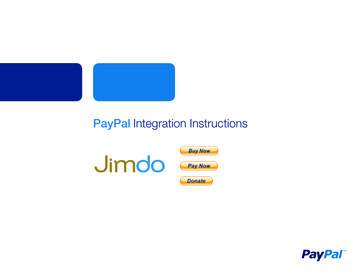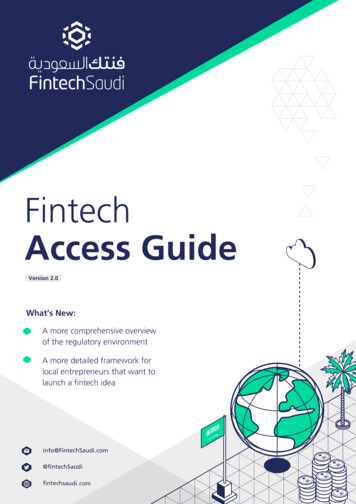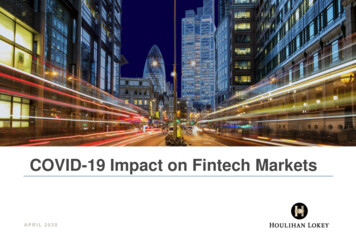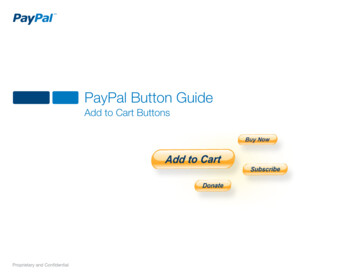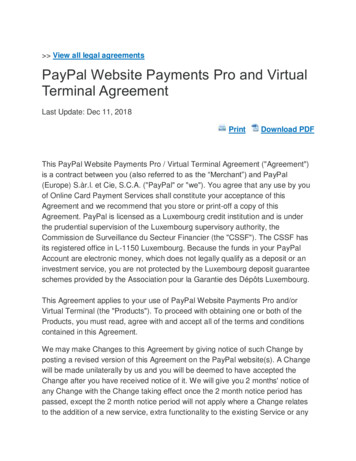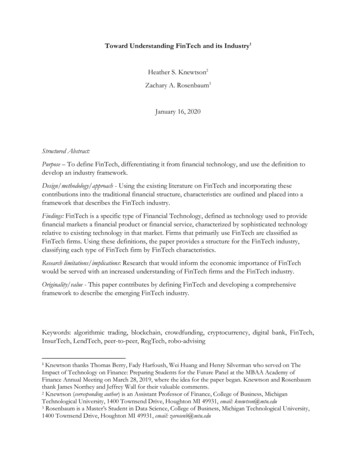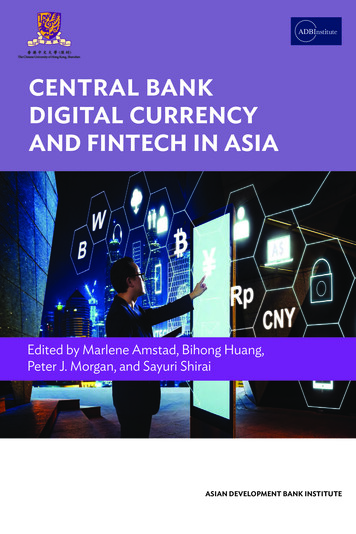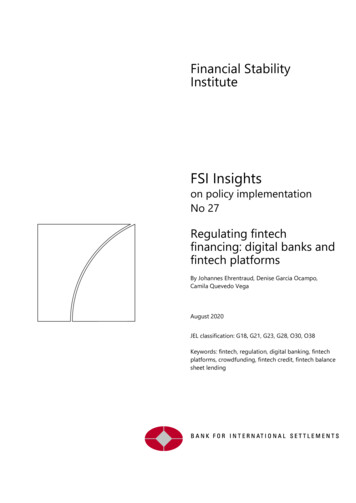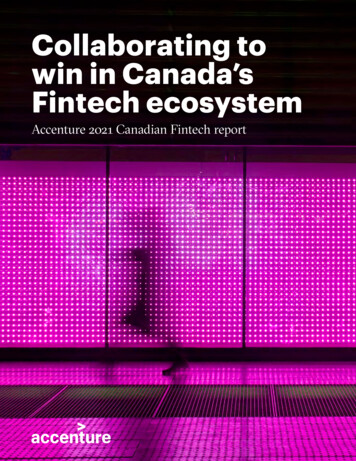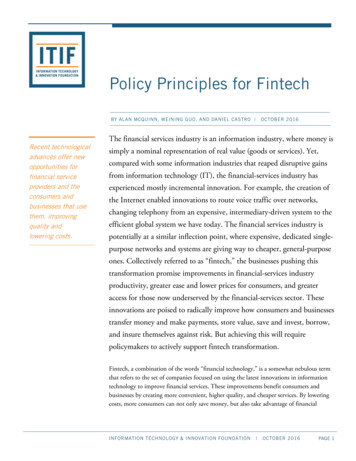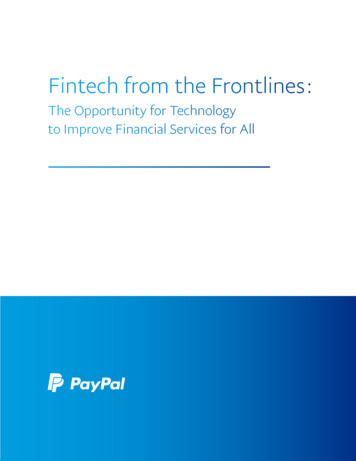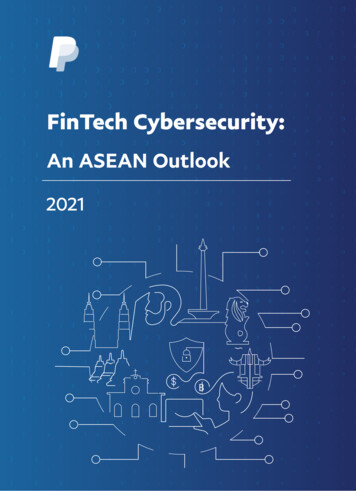
Transcription
FinTech Cybersecurity:An ASEAN OutlookB
INDEXExecutive Summary01Introduction06FinTech in ASEAN08› FinTech: Improving financial inclusion in ASEAN10› Digitalization and access to finance for SMEs11› Innovations for the region and the world13› FinTech and cybersecurity: A relationship worth understanding13Cybersecurity Ecosystem in ASEAN16ASEAN FinTech Cybersecurity Matrix19Findings of the PayPal ASEAN Cybersecurity Survey26Recommendations33Appendix: Country Cybersecurity FinTech Ecosystem Snapshots43References63
EXECUTIVE SUMMARYSoutheast Asia’s FinTech sector is growing at an exponential rate. In 2019 alone, digital financial services in theregion generated USD 11 billion of annual revenue – a figure that is expected to more than triple to reach USD 38billion by 2025.1unbanked population in Southeast Asia could result in an increase of economic contribution of USD 35 billion by2030.2 In the aftermath of COVID-19, the ASEAN region, like the rest of the world, is focusing on economicrecovery.3 The ASEAN economies’ dependence on trade with other economies that have also been badlyplummeting domestic demand have led to negative growth rates in economies across the region.4 As a result, therole of digitalization and technology solution providers in sustaining the regional economy is more importantthan ever.The small and medium enterprise (SME) sector, that accounts for between 89% and 99% of total establishmentsand between 52% and 97% of total employment in the ten ASEAN Member States, is the backbone of theregional economy.5 FinTechs provide numerous technology-enabled solutions to the region’s booming SMEsector in the form of innovative payment mechanisms, credit products, fraud protection systems, anddata-enabled financial risk assessment solutions. Global payment service providers like PayPal enable SMEs inthe region to expand their reach and sell to customers around the world.Moreover, FinTechs in the region are catalysts for innovation across the financial, technological, and SMEecosystems. Interest in these FinTechs from global players also creates global networks for collaboration andpartnership.As ASEAN focuses on recovery from COVID-19, there is increased impetus for investments in digitaltransformation to nurture the regional entrepreneurial ecosystem, as well as to connect government, business,and citizens real-time. FinTechs are an important part of this chain and consumer trust in them is paramount tomalicious actors who target vulnerable users globally, predominantly with the aim of financial gain. Globally,cybercrime causes trillions of dollars in losses each year.USD 10.5trillionUSD 6trillionUSD 2.71USD 3USD al cost of cybercrimeAverage cost of breach in ASEANSource: cybercrime-report-2016/Source: https://www.ibm.com/sg-en/security/data-breachAs the FinTech sector becomes a vital contributor to the ASEAN regional economy, its growth as well as the newlydigitalized populations of the region render it an attractive target for cybercriminals. According to the 2020ASEAN Cyberthreat Assessment Report by Interpol, “No country or organization in the ASEAN region is sparedthe threat of fast-evolving cybercrime. Given their position among the fastest-growing digital economies in theworld, member countries in ASEAN have become a prime target for cyberattacks.”6EXECUTIVE SUMMARY1
“No country or organization in the ASEAN region is spared the threat of fast-evolvingcybercrime. Given their position among the fastest-growing digital economies in theworld, member countries in ASEAN have become a prime target for cyberattacks.”Source: 2020 ASEAN Cyberthreat Assessment Report by InterpolIn the absence of cyber resiliency and adequate defenses, innovative products and services can be the verymedium through which malicious actors succeed in defrauding their victims. Additionally, the newly digitalizedand the recently financially included are especially vulnerable to their attacks - a stark truth that was underscoredby online scams perpetrated during the COVID-19 pandemic.As a result, regulators in the region have placed great emphasis on cybersecurity and in recent years, we have seenthese measures follow a one-size-fits-all approach across sectors, the burgeoning FinTech ecosystem in the regionoften finds that well-meaning regulations may place rather tall hurdles in their race towards innovation andgrowth.Recognizing the challenges in reconciling regulatory flexibility with prioritizing cyber hygiene for enhanced cyberresiliency in the regional fintech ecosystem, PayPal has collaborated with a boutique consulting firm, TRPC, toshare this ASEAN FinTech Cybersecurity Study. Through this study, we seek to better understand the impact ofcybersecurity regulations on FinTech firms in the region and to provide a balanced perspective on ways to achievesustainable growth in the ASEAN FinTech sector without compromising safety and security of customers andtheir finances.In order to do so, the study draws on the following original sources in addition to an extensive literature review :The 2019 PayPal ASEAN FinTech Cybersecurity Survey which was conducted amongst 44 FinTech firmsacross ASEANThe PayPal ASEAN FinTech Cybersecurity Matrix which assesses the cybersecurity regulatory ecosystem inthe regionThrough our survey, we found that FinTech firms inthe region are diverse in size and scope. While thesefirms care deeply about cybersecurity, they arespending disproportionately on cybersecuritycompliance – without necessarily receivingcommensurate returns in terms of cyber resilience.We also found that there is an immediate need forenhanced public private engagement forums whereFinTech firms and governments can collaborate onissues pertaining to cybersecurity and financial riskin order to nurture and maintain trust in theecosystem.EXECUTIVE SUMMARY2
THE MATRIX ASSESSES THE ASEAN MEMBER STATES UNDERFIVE KEY PILLARS :Legal andPolicyCyber Hygieneand FinancialLiteracyKnowledgeand SkillsStakeholderCommunicationand CollaborationInvestmentand SpendingThe ASEAN nations are at varying stages of cyber readiness with a diverse regulatory environment across theregion, varying levels of national engagement in capacity building for the FinTech industry, as well as an ASEANwide cybersecurity skill gap challenge faced by FinTech firms. An encouraging result, however, is the presence ofnumerous bilateral and multilateral agreements across the region, many of which indicate the commitment tocollaborate on resolving these issues.KEY RECOMMENDATIONS :Develop principles-based cybersecurity regulations and frameworks driven by outcomes andevolving risksOver two-thirds of the respondent firms in our surveyreported that compliance requirements are the key driversfor their investments in cybersecurity. At the same time, it isan oft-quoted truism amongst cybersecurity professionalsthat compliance does not equal security. ASEAN needs tomove away from a rigid box-ticking approach towardscybersecurity to one that incentivizes investments in cyberresilience. We recommend risk-based requirements that canhelp ease undue regulatory burden while also ensuring thatcompliance boosts customer safety.EXECUTIVE SUMMARY3
Enable adoption of strong cyber hygienethrough ASEAN-level compatibility as wellas alignment with global security standardsASEAN FinTech has the opportunity to reap thebenefits of regional economies of scale. However,this can only be made possible if cybersecurityregulations and norms across the region arestandardized.and risk mitigation. The long-term goal of theseendeavors should be the creation of an ASEAN-widesandbox – one that can help companies test theirproducts designed with an ASEAN regionalconsumer base in mind.Establish comprehensive programs fortraining and awareness on fraud andsecurity best practices for general publicand businessesEven the most sophisticated defense systems, themost advanced infrastructure, and the most rigorouscybersecurity laws cannot protect an ill-informedend-user. Newly-digitalized consumers are especiallyvulnerable to cyberthreats and scams. As a result,Cyberthreats are cross-border in nature anddefending against them requires a collaborativeapproach. ASEAN should create an evolving regionalcybersecurity framework that is aligned with globalstandards and practices. Such a framework wouldenable exchange of innovative cyber defensemeasures and expertise and ensure the retirementof legacy processes that hinder technologyadoption.governments, businesses, and academic institutionsto educate the public about cyberthreats and themeans to protect themselves against them. Werecommend the establishment of a region-widerepository of cyber scams and threats forinformation sharing.Promote a multilateral regulatory sandboxforknowledgesharingandriskmanagement in the FinTech ecosystemSandboxes enable regulators to foster innovation inthe FinTech ecosystem while also understandingpotential risks of new products and the ways toprotect their citizens and financial systems againstsuch risks. Each ASEAN nation should host its ownnational sandbox in order to fully realize the benefitsand the potential of the FinTech sector while alsoidentifying country-specific risks and challenges.We recommend the establishment of formalizedchannels of collaboration and knowledge-sharingbetween national sandboxes in ASEAN to enablefintech companies in the region to benefit from eachother’s experiences and collaboration on innovationFurthermore, ASEAN governments can implementand encourage internationally recognized bestpractices on anti-virus, patching, and anti-phishingstandards.Invest in developing a strong cybersecurityworkforce to support a resilient ecosystemEven as the cyberthreat landscape continues toexpand, about 3.5 million cybersecurity positionsglobally are expected to go unfilled in 2021.7 In oursurvey, we found that more than a quarter of FinTechfirms do not have a dedicated cybersecurity expert intheir organization. We recommend ASEANgovernments to work closely with the private sectorto boost talent development and support the needsof the growing financial services industry. Animportant first step towards planning for the futurewould be the introduction of cybercrime mitigation,data analytics, automation technologies andcybersecurity skills in the primary and secondaryEXECUTIVE SUMMARY4
educations stages of the schooling systems in ASEAN, witheducational pathways drawn through to university. Weencourage the public and private sector to work together toencourage under-represented groups in the field ofcybersecurity, such as women and mid-career workers toconsider a career in the sector. Additionally, ASEAN can seeimmense benefits from exploring innovative schemes likecredential passporting across the region to enable easiermovement of cybersecurity talent across Southeast Asia.Encourage public-private partnerships in research, hiring and information sharingMulti-stakeholder consultative processes must become thenorm in the creation of new cybersecurity regulations andpolicies. We encourage the creation of public private forumsfor stakeholders from a diverse range of institutions toconsult with each other on new regulations, training needs,and to share best practices. Additionally, we encouragetogether experts across the public, private, and academicsectors to create innovative solutions in cyber defense.EXECUTIVE SUMMARY5
INTRODUCTIONTechnology advancements are enabling financial service providers to serve more customers at a lower cost,development of new types of products, services, and platforms. It is also creating new sources of economic growth,particularly for Micro Small and Medium Sized Enterprises (MSMEs), by providing access to global capital andmarkets.From mobile digital wallets to automated insurance advisors and the provision of microloans to small and mediumenterprises (SMEs), the prevalence of FinTech is rapidly growing in economies that were predominantlycash-based just a few years ago. According to the World Bank, digital financial services such as mobile paymentservices and digital saving accounts are reaching significant scale in both emerging and mature economies.8490 In 2019, there were more than 490 FinTech startupsregistered in Singapore alone.In ASEAN, the FinTech sector has seen tremendous growth. Southeast Asian FinTechs such as GoJek and Grabrose from humble beginnings to become digital economy juggernauts. Inspired by their success and attracted bythe region's market potential, new players regularly enter the fray. As of 2019, there were more than 490 FinTechstartups registered in Singapore alone.9The Southeast Asian FinTech story is distinguished by interest from investors all over the world. FinTechcompanies in Southeast Asia raised over USD 8.9 billion across 475 deals between 2015 and 2019.10 In 2019 alone,FinTech investment in ASEAN reached a record USD 4.1 billion across 130 deals.11 In the same year, digital financialservices generated USD 11 billion of annual revenue across Southeast Asia – a figure that is expected to more thantriple to reach USD 38 billion by 2025.12This burgeoning FinTech scene has immense potential. More than half of the adult population in the ASEANregion is still unbanked, with large segments of the population living in remote rural areas.13 In 2016, a regionwideKPMG study found that only 27% of the population across Southeast Asia had a bank account.14 While this isexpected to have risen to 47% in 2018, millions of people remain unbanked or underserved in the region.Therefore, the region has some way to go in ensuring financial inclusion. Many of the access issues caused by thegeographic fragmentation of the region can be overcome through technology.COVID-19 has been a catalyst for digitalization as businesses are rapidly adaptingtheir strategies to evolve with changing consumer behaviors.COVID-19 has been a catalyst for digitalization as businesses are rapidly adapting their strategies to evolve withchanging consumer behaviors. We have witnessed a tremendous shift in commerce and financial services and theglobal pandemic has revealed gaps in business continuity plans and IT operations. The rapid pace of digitalizationglobally has also spurred on governments across the world to explore emerging possibilities in FinTech such as theneed for nationalized instant payment systems, dissemination of government subsidies through digital payments,and development of central-bank issued digital currencies for cross-border trade. The pandemic has also led tothe emergence of new cyberthreats and attacks created around the themes of COVID-19 government subsidiesand remote working.INTRODUCTION6
Maintaining robust cybersecurity and resiliency against cybercrime are key for businesses to scale and thrive inthe ASEAN digital economy. Without the assurance that their money and data are safe, customers will not be ableto place their trust in the digital economy. At the same time, cybercriminals increasingly use sophisticated andcomplex attack vectors to target individuals, businesses, and even nation states.ABOUT THE STUDYthe region, ASEAN government agencies andregulators have introduced or considered newregulations and frameworks for the FinTechindustry. The aim of this ASEAN FinTechCybersecurity Study (“the study”) is to understandthe implications of regulations on the growth,strategy, and resource allocation of FinTech firms inthis region. This report is commissioned by PayPaland authored by PayPal and TRPC, a boutiqueconsulting firm specializing in telecommunicationsand information technology with an emphasis onthe Asia Pacific region. The purpose of this study isto assess cyber readiness, with an emphasis on cyberBased on the results of the survey, andcomplemented by open source research, we createdthe PayPal FinTech Cybersecurity Matrix (“thematrix”) to assess and analyze the cybersecurityregulatory ecosystem in the region for FinTechcompanies in the ASEAN member states.The matrix consists of 12 questions grouped underfive pillars:Legal and PolicyKnowledge and SkillsInvestment and SpendingCyber Hygiene and Financial Literacyof the ASEAN nations, and to provide an objectiveStakeholder Communication and CollaborationFinTechs in the region with the safety and securityof customers and their finances.The matrix is designed as a standalone reference inIn order to do so, this study examines variousaspects of ASEAN's cybersecurity ecosystem as itrelates to FinTech companies in the region. Thefoundation of this study is a survey that wasconducted among ASEAN fintech firms in late 2019.The PayPal ASEAN FinTech Cybersecurity Surveywas launched to gauge ASEAN FinTech firms’ ties as well as the rapidly evolvingcybersecurity regulatory landscape in the region.Over 40 firms responded to the survey.Cybersecurity Index.15Additionally, the findings of the survey and thematrix are supplemented by extensive literaturereview and insights drawn from PayPal’s ownexperience, both globally and regionally. Drawingfrom these four sources (the survey, the matrix,literature review, and PayPal’s experience), weconclude this study with recommendations forconsideration by key decision makers in the region.INTRODUCTION7
FINTECH IN ASEANThe FinTech industry is at the forefront of ASEAN’s economic growth, with estimates for the region’s digitaleconomy showing a rise from USD 100 billion in 2019 to USD 300 billion in 2025.16 Even amidst a general downturnin startup funding due to the COVID-19 pandemic in 2020, Southeast Asian FinTech startups raised 1.25 billionin aggregate across 125 deals.17 For the purposes of this study, we define FinTech companies as "organizationscombining innovative business models and technology to enable, enhance, and deliver financial services."18FinTech companies have played an important, if not leading role in the digitalization of the Financial ServicesIndustry (FSI) in Asia.One of the fastest growing segments of FinTech is digital payments, especially in ASEAN where there has beenrising adoption of digital payments. Figure 1 represents the growth of digital financial services in the region andthe steady increase of digital payments from 2014 to 2017 across the region. According to the 2019Temasek-Google-Bain e-economy SEA report, the adoption of digital payments in ASEAN is expected to crossUSD 1 trillion by 2025.19Figure 1:Proportion of adult population that had made or received a digital payment in the past D62%18%VIETNAM23%20142017Note: No data available for Brunei Darussalam. Data unavailable for Lao PDR for 2014. In 2017, the figure was 13%. Source: The World Bank Global Findex Database 2017FINTECH IN ASEAN8
While the FinTech ecosystem in ASEAN isdominated by payments and mobile wallets,constituting nearly half of the industry by someIn addition, with the recognized growth potential ofASEAN economies, an increasing number ofinvestors and innovators are attracted to the region.and products such as lending, financial comparisonand retail investment.20The rise of FinTech solutions in ASEANis underpinned by the rapid adoptionof technology, high mobile and internetpenetration, and an increasingly educatedyoung and urbanized population.The rise of FinTech solutions in ASEAN isunderpinned by the rapid adoption of technology,high mobile and internet penetration, and anincreasingly educated young and urbanizedpopulation. The region has been underserved bytraditional financial institutions, and increasingdigital connectivity and upward income mobility inthe region are leading customers towards theadoption of FinTech solutions. As a result, ASEANnow boasts numerous homegrown FinTech serviceproviders whose first-hand understanding of thegaps in the ASEAN FinTech ecosystem enable themto provide targeted solutions to fill these gaps.Table 1:Factors driving FinTech growth, and economic impact of FinTech on ASEANFACTORS DRIVING FINTECH GROWTHRapid adoption of technologyHigh internet and mobile penetrationIMPACT OF FINTECH INNOVATION ONASEAN ECONOMIESCatalyst for increased economic activity fromfinancial inclusion, and new services, e.g.reaching the unbanked, increasing youthbankingIncreasingly urbanized, tech savvy populationImproved access to credit and finance for SMEsFinancial inclusion policies targeting traditionallyunderserved populations - e.g. young, rural,unbanked and underbankedData and analytics provide SMEs withinformation on consumer behaviors to improveprofitabilityInnovative business ideas and the possibility ofbeing the "next unicorn" inject venture capitaland drive entrepreneurial spiritFINTECH IN ASEAN9
FINTECH: IMPROVING FINANCIAL INCLUSION IN ASEANFinTech companies have the potential to acceleratefinancial inclusion in the region, resulting inincreased economic activity. It is estimated thatleveraging digital technology to increase financialinclusion could boost GDP by 2% to 3% in marketssuch as Indonesia and the Philippines, and as muchas 6% in Cambodia.21 According to a 2016 KPMGreport, reaching the unbanked population inSoutheast Asia could result in an increase ofeconomic contribution of USD 35 billion by 2030.22Traditional financial services are unable to bridgethis gap for a number of reasons. First, as ASEAN isa geographically diverse region, traditional bankingmodels face challenges in reaching customers inremote areas. Underbanked communities oftenmake small, frequent transactions which areencumbered by traditional transaction fees andentity and are determined by multiplesocio-economic and even geographic factors.bespoke products thatindividualized needs.cancatertosuchHowever, FinTech can address many of thesechallenges. It is estimated, for instance, that globally,two-thirds of unbanked individuals have access to amobile phone.23 The right FinTech solutions canenable these individuals to join the financial systemwith the aid of their mobile devices.FinTech companies have focused on payments andmobile wallet solutions as a first step towardsfinancial inclusion. The results have beenimpressive. In 2019, 61% of consumers in Vietnamused some form of mobile payment (up from 37% in2018),24 while most consumers in Indonesia,Malaysia, the Philippines, Singapore, and Thailandhave made purchases through social mediaplatforms like Instagram and Facebook.25Additionally, homegrown FinTech players in theregion are also leveraging their deep understandingof local contexts and country-specific challenges toprovide innovative and highly tailored solutions tothe unbanked and underbanked. For example, Julo,an Indonesian FinTech provides tailormadePeer-to-Peer (P2P) lending solutions targeted at theunbanked population.opportunity that lies in serving the needs of thebottom-of-the-pyramid income segments that areoften overlooked by traditional financial institutions.They recognize that the underbanked and unbankedrequire services that go beyond deposit andproducts. In Malaysia, for instance, mobile appHelloGold makes investing in gold accessible to themasses by allowing its customers to buy and sell goldin any amount from RM1 (USD 0.23) – providing theopportunity for customers from all walks of life toinvest in a commodity that was previously restrictedto the middle and upper income groups.Therefore, FinTechs have the power to expandbeyond “financial inclusion” and encompass thebroader goal of universal financial health – whichgoes beyond mere account ownership to ensuringthat these accounts are useful, versatile, andappropriate to individualized needs.FinTechs have the power to expandbeyond “financialinclusion” andencompass the broader goal of universalfinancial health – which goes beyondmere account ownership to ensuringthat these accounts are useful, versatile,and appropriate to individualized needs.FinTechs in the region, with their can-do spirit andout-of-the-box thinking have identified the marketFINTECH IN ASEAN10
and timely access to funds is of great importance to the financially underserved. FinTech’s ability to service themis therefore heavily reliant on technology adoption and the availability of digital infrastructure.Additionally, continuous regulatory oversight is required to ensure that any operational or systemic risks,for welfare assistance during the COVID-19 crisis.26 Disruptions in access to services or products could haveDIGITALIZATION AND ACCESS TO FINANCE FOR SMALL ANDMEDIUM ENTERPRISESSMEs are the backbone of Southeast Asianeconomies; but the ASEAN SME sector continues toface funding and credit challenges. The SME loan toGDP ratio is low in most ASEAN nations, with figuresranging from 3% to 34%.27 Banks in the region havehesitated to finance SMEs as traditional credit riskassessments often put in place stringentrequirements that SMEs are unable to meet,especially in the early stages of their growth.For first-time entrepreneurs, startup capital can befinancial institutions rely on long-establishedmodels of credit risk assessment which requireextensive financial history data or proof of collateral.Particularly in developing countries, there are many“thin-file” customers who cannot furnish such datarecords. The limited availability of traditional datafor credit risk assessment impacts banks’ lendingdecisions, driving higher interest rates for SMEs orlimiting financing outright.alternative data that can enhance credit analysismethods to provide a more holistic understanding ofsmall businesses that might otherwise bedisadvantaged by limited credit history.28 FinTechcompanies can address this funding gap in manyways. Some FinTechs can play the role ofintermediaries connecting emerging SMEs andstartups with interested investors. For instance,Amartha is a P2P lending marketplace in Indonesiawhich directly connects micro ngapore-grownFinTechInvoiceInterchangeprovides working capital solutions for businessgrowth through the provision of an invoice financingmarketplace - enabling businesses to overcome cashflow fluctuations by selling their outstandinginvoices to a network of investors.FinTechs also enable SMEs to obtain better accessto loans by providing alternatives to traditionalcredit risk-assessment by using digital paymentplatforms and analytics to provide a more holisticpicture of an enterprise’s financial health andprospects. Innovation in SME financing facilitated byFinTechs has several long-term benefits includingenhancing resiliency and agility during times of crisisor volatility.Innovation in SME financing facilitatedby FinTechs has several long-termbenefits including enhancing resiliencyand agility during times of crisis orvolatility.Technology can also enable the collection and use ofFINTECH IN ASEAN111
Additionally, they provide an avenue for newenterprises to build credit history that can unlockthe doors to more substantive loans to support theirlong-term growth.29The ability to participate in global trade enablesmerchants on global platforms like PayPal tooutperform their counterparts who may be focusedon domestic markets alone. In Vietnam, between2013-2017, exports by Vietnamese small businesseson the PayPal platform grew ninefold.Global payment service providers likePayPal enable SMEs in the region tosell to customers around the world.The number of export destinations reached byPayPal small businesses in Vietnam increased from132 in 2013 to 169 in 2017, a 28% increase. In fact,SMEs on PayPal had more trade partners than theirconsumers in 14 and 18 more markets, respectively.31Additionally, global payment service providers likePayPal enable SMEs in the region to sell tocustomers around the world. PayPal operates atwo-sided global technology platform thatfacilitates the processing of payment transactionsfor over 361 million30 active account holders globally.PayPal enables consumers to safely exchange fundswith merchants using a variety of funding sources.payments solution that provides authorization andsettlement capabilities, and fast access to funds.PayPal’s consumers engage in cross-bordershopping and merchants extend their global reachwhile reducing the friction in cross-border trade.Through the PayPal platform, merchants in ASEANare able to sell to customers in more than 200markets.From 2013 to 2017, exports by Vietnamese smallbusinesses on the PayPal platform grew by 9 timesFINTECH IN ASEAN12
INNOVATIONS FOR THE REGION AND THE WORLDApart from creating an inclusive financial ecosystem,FinTech companies are catalysts for innovation inASEAN. With fresh ideas and solutions on howfinancial services can operate outside legacyinfrastructures, they can address a range of issues.For example, unicorns like Grab and GoJek areleading access to financial services, at a scale thattraditional banking has never been able to achieve. Itis estimated that half of GoJek’s 100 million monthlytransactions are processed through their e-wallet,GoPay.32 GrabPay now allows low-cost moneytransfer services, enabling users to remit moneysecurely in another country at far lower costs thanusing traditional banking.33In addition to this, FinTechs that have proven themselves in the complex and competitive arena of the SoutheastAsian digital economy attract investments from global players who can support them in their aspirations toextend beyond the region. In June 2020, for instance, PayPal announced a commercial partnership with GoJekthrough which PayPal’s payment capabilities will be integrated into GoJek’s services in order to allow customers ofGoPay, Gojek’s digital wallet, to gain access to PayPal’s network of more than 25 million merchants around theworld.Establishing a conducive regulatory environment is important to support the growth of these FinTech businesses,ASEAN region.FINTECH AND CYBERSECURITY: A RELATIONSHIP WORTH
The Southeast Asian FinTech story is distinguished by interest from investors all over the world. FinTech companies in Southeast Asia raised over USD 8.9 billion across 475 deals between 2015 and 2019.10 In 2019 alone, FinTech investment in ASEAN reached a record USD 4.1 billi
